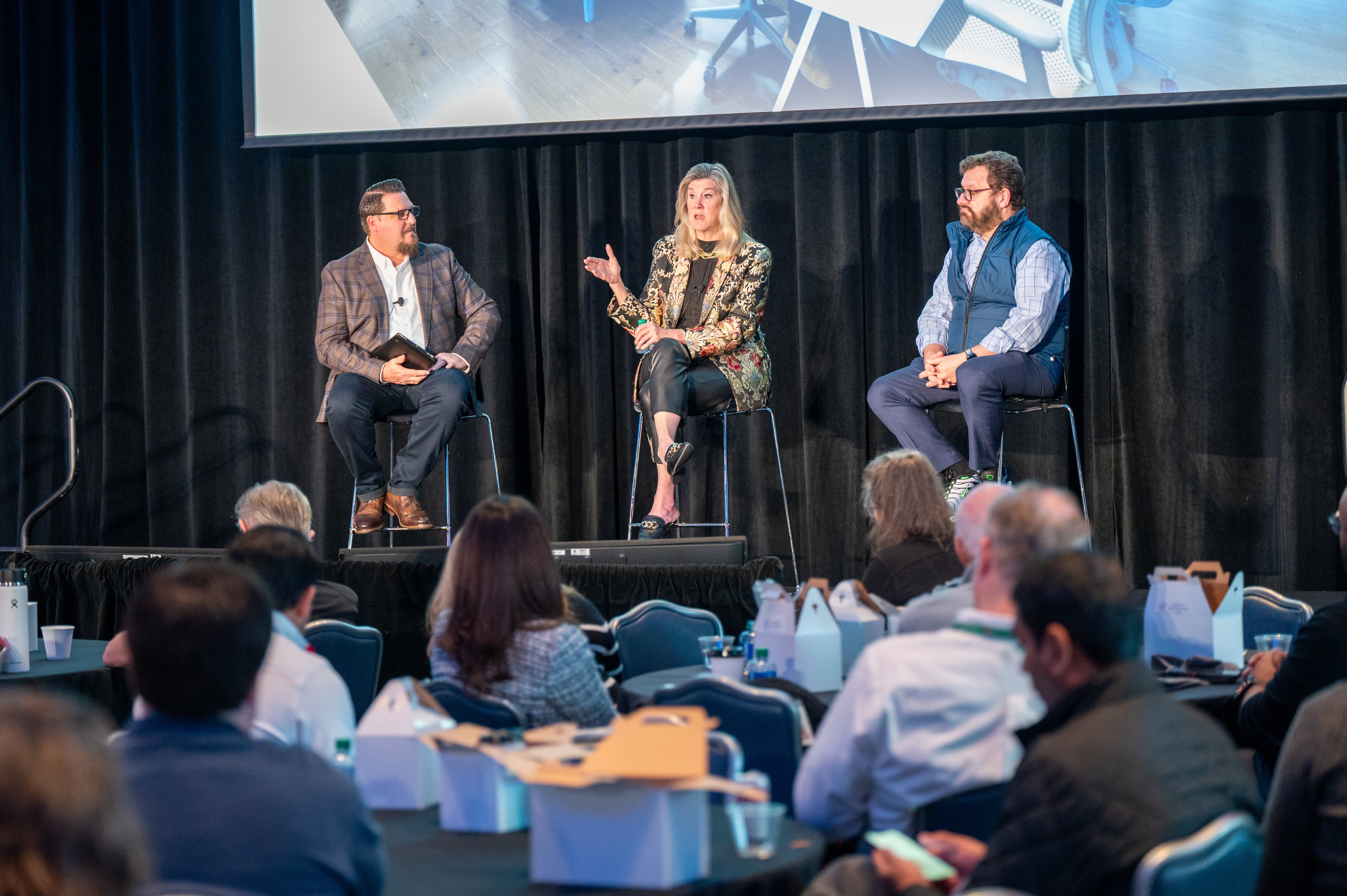 |
At our first AVI LIVE of 2024 (at the beautiful Georgia Aquarium in Atlanta), we asked Kay Sargent, Director of Workplace Thought Leadership at the global design firm HOK, to kick off the event by discussing the future of work. In a thought-provoking style, Kay shared why she believes the modern workplace is at a tipping point. |
The idea of hybrid work has existed much longer than many companies realize. In some cases, companies adopted what was ostensibly a hybrid work model a decade or more ago. Then, the idea of co-working started disrupting the office sector, and COVID took it to the next level. So, hybrid work isn’t new. What’s different now is the scale.
As a result, Kay believes that the commercial real estate industry is facing a pivotal time of change that will have far-reaching implications for the modern workplace. In the simplest terms, we’re going through a broadscale societal shift, and the pace of change will only ratchet up exponentially from here.
How is your workplace performing?
If you’re wondering how to “future-proof” your office space, Kay recommends focusing instead on making it “future-ready.” To get started, ask yourself these questions to determine how well your current space is performing:
- Can you get into and out of your real estate quickly?
- Are your spaces flexible or agile enough to change them as needed?
- Do your meeting spaces meet the needs of your employees?
- Are you leveraging technology enough?
- Are you creating enticing spaces where people want to be?
- Do you have data about what is happening in your workspace?
- Are your spaces designed to support health and well-being?
- Are you addressing environmental sustainability and climate change?
- Are you supporting and enabling people to work from anywhere?
- Are you addressing diversity, equity, and inclusion in your spaces and policies?
As you address any gaps, it’s important to note that your staffing strategy should drive your real estate strategy. In other words, hybrid is more of an operational model than a workplace solution.
In addition, there are behavioral components that must be addressed along with your workplace strategy. For example, you can design a fantastic space with the best AV and technology. But if people tend to sit at their desks and join Teams calls while multitasking, that’s not a challenge that space design can solve.
How can you build a modern workplace strategy?
Kay’s team at HOK has identified 12 things that companies need to do to create successful workspaces:
- Determine your model of work – addressing both time and place.
- Adjust your real estate to optimize space and create enticing places people want to be.
- Create a sustainable ecosystem of space with options and choices.
- Develop protocols and guidelines to support distributed work.
- Retrain managers to manage by performance, not presence, and how to provide more equitable and inclusive engagements.
- Address physical and psychological health, safety, and well-being.
- Reassess meetings and gather profiles to create the right spaces.
- Focus on innovation and quality, not just productivity.
- Ensure ample opportunities for teaming, rebuilding social capital, and building community.
- Rethink communication with your team and be more intentional about it.
- Rethink how you address recruitment, onboarding, and professional development to provide equity and advancement for all.
- Embrace testing and build periodic checkpoints to ensure things are going in the right direction. Make adjustments when needed.
You’ll notice that just five of these points relate to the physical workplace, and the rest focus on retraining managers, reconsidering onboarding and operations, having policies and procedures, and thinking things through for the long term.
Advice for the journey: industry experts weigh in

To navigate the unique challenges that organizations face today, our AVI Live event in Atlanta also included a panel discussion moderated by Jason Roberts, AVI’s Director of Audiovisual and Enterprise Practice. Kay was joined by Roy Abernathy, the EVP and Practice Leader at Newmark. Following is a summary of Kay and Roy’s top tips.
Framing what’s possible
- Kay Sargent: In the past, large-scale projects started with a visioning exercise. Now, that process is less effective because most companies have had their workplace reality turned upside down and don’t even know what’s possible. As a result, vendors like HOK, Newmark, and AVI Systems can no longer start by asking, “What do you want?” Instead, our role is to help you understand what’s possible.
- Roy Abernathy: Tech now plays a more active role – it’s the bridge to data, AI, and more. As such, it’s important to view technology as a service rather than a device (which makes investing in tech more flexible). To understand what’s possible, don’t just think about what tech you feel you need. Instead, ask what you need the tech to support. This could include moving away from standards and toward different spaces that require technology to do different things.
The role of the office and the importance of gathering with others
- Kay Sargent: Certain things are just harder to do virtually. For example, building social capital with people you’ve never met or rarely see in person is harder. Because of this, I think companies will have less space in the future, but it will be better space designed for effectively gathering with others.
- Roy Abernathy: I don’t think the office will disappear, but its definition will change. Most of us want to be part of something that has a purpose. At Newmark, our newer and younger employees have told us definitively that coming into the office connects them to others and that working remotely has significantly impacted onboarding, in particular.
Having a flexible definition of the workday
- Kay Sargent: Depending on your industry, having core hours can be important. That said, we are grossly oversimplifying the conversation when we make rules that apply to everyone because people’s tasks, needs, and preferences are diverse. A one-size-fits-all approach will only misfit all.
- Roy Abernathy: As an employer, I think it’s important to consider why you care when people work. Historically, it’s because leaders wanted to know what people were doing, but it’s time for that paradigm to shift. Organizations that realize workers' preferences change over time will have more productive employees. Our assembly-line approach to work in the U.S. is probably the aspect of work that’s the most broken.
Their final piece of advice
- Kay Sargent: If I could encourage companies to focus on one thing, it’s to embrace change because it’s not going away. Things are evolving quickly, and if you don’t adapt soon, you’ll be left behind by the competition. Being future-ready might include adding more dollars to your refresh budget or switching to a subscription model. Your goal should be to embed the capability to stay current and create amazing experiences for people.
- Roy Abernathy: I recommend companies stop talking about places and tech and instead start talking about the behaviors they’re trying to drive. For example, look at your spaces and observe what people are doing and how they’re engaging in conversation (paying particular attention to what behaviors aren’t helpful). If you approach it from this perspective, you’ll be better positioned to achieve the right balance of people, place, and tech.
Thanks again to Kay, Roy, and Jason for a lively conversation about how companies can adapt to the changing workplace. If you need help navigating the current environment, contact AVI Systems today.









